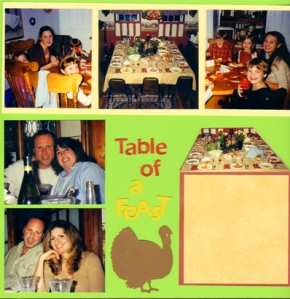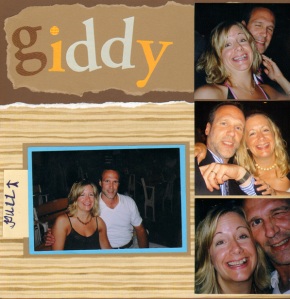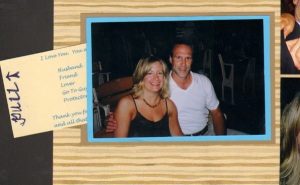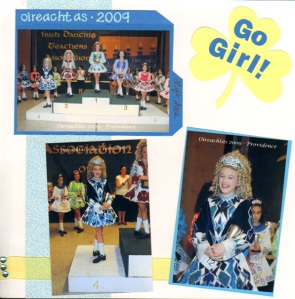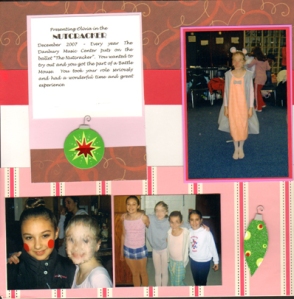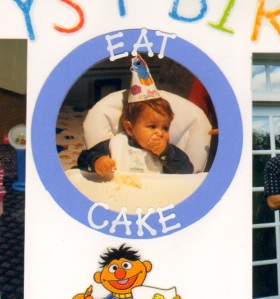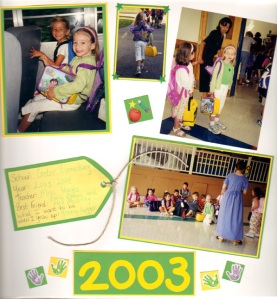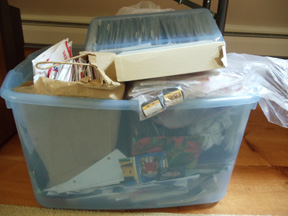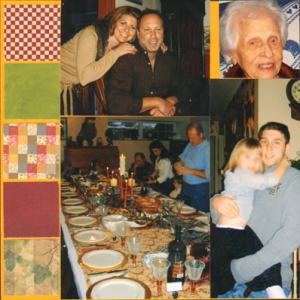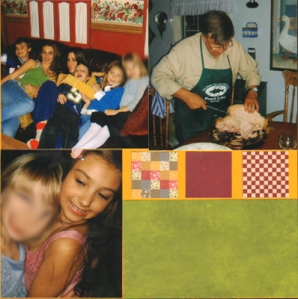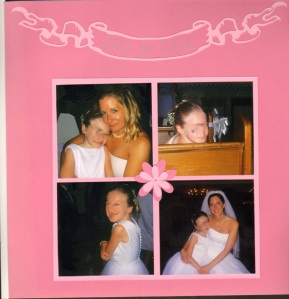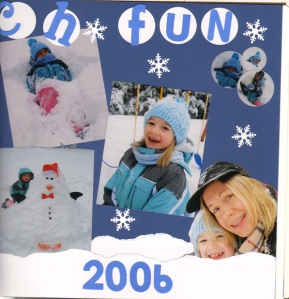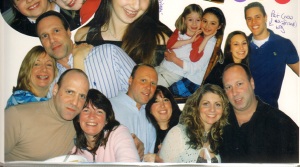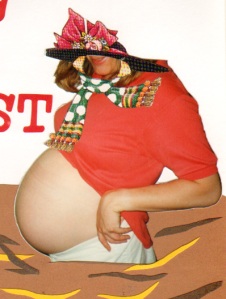Category Archives: scrapbook layouts
Confetti Pockets for Summer Layouts
Hi all! Back in April I showed an instructional video on how to make confetti pockets for your scrapbooks. Today I’m going to show you how to do a confetti pocket for your summer layouts! All you need for this project are the following:
- Memorabilia Pocket Size 8.5″x3″
- Cardstock – several colors of your choosing
- Paper punch
- Alphabet stickers or die cut machine
- Glue stick and/or tape runner
- Scissors/paper trimmer
For this project, I used mini fish and starfish paper punches that I borrowed at a crop I attended (Creative Memories). If you do not own either of these types of punches, using a hole punch will work just as well. Make your confetti first to get it out of the way. Choose cardstock colors that remind you of summer, I used yellow and orange. This part is a bit time-consuming because you will want to punch at least 50 shapes for your pocket.
Next, you will need at least a 8.5 x 3 inch keepsake envelope. If you don’t have one or can’t find one in a store, you can make one by using the instructions here.
Using two different pieces of colored cardstock (I used blue and green), cut out 2 backgrounds. The first background (blue) needs to be cut down small enough to fit inside the envelope. The second background (green) needs to be a bit larger because it will be adhered behind the finished pocket.
Using my Cricut machine, I cut out a sun and letters that spell out “BEACH” and adhered them to the foreground paper near the top. Next, I created waves by ripping 3-4 different shades of blue cardstock and then layered and adhered them to the bottom of the foreground paper. Trim off any excess. Then insert this piece of paper into the pocket followed by the confetti in front of it. Seal the envelope closed. Adhere the envelope to the slightly larger piece of background paper and you are done!
If you are a visual person like me, check out my video to see how it’s done:
Journaling Tips for Your Scrapbook Layouts
 As a follow-up to my “Waste Not, Want Not” blog, I wanted to show some different journaling techniques. I am a journaling NUT. Not because I love to write, but because I feel this weird need to chronicle every single thing I can possibly remember about the event I am scrapbooking at the moment.
As a follow-up to my “Waste Not, Want Not” blog, I wanted to show some different journaling techniques. I am a journaling NUT. Not because I love to write, but because I feel this weird need to chronicle every single thing I can possibly remember about the event I am scrapbooking at the moment.
For years, I thought the only way to do this journaling was to handwrite everything. If you look through my scrapbooks, you will see my incredibly sloppy handwriting EVERYWHERE! Smack in the middle of a page, at the bottom, squished in the top, like I said EVERYWHERE! YUCK! It’s unsightly to say the least.
Well, guess what? I discovered that handwriting your journaling is not the only way to go. Here are some ways that I now like to incorporate journaling into my scrapbooks:
- Journaling box (oldie but goodie)
- Hidden journaling
- Printer journaling
- Write around or directly on top of the photograph – major space saver
- Tags
Journaling Box – In this layout, room was made for a journaling box. This is where you journal either with your own handwriting or via printer.
“Pull Here” tab – This is categorized as “hidden journaling.” This photo is double-matted. In between the two mats I left room for a pull tab that contains journaling by only adhering 3 sides of the mat.
Another form of “hidden journaling” – here the journaling is behind the photo. The reason for this is because there wasn’t enough space on the page for journaling. For this photo, I cut out the mat to resemble a file folder. Using my paper trimmer with the scoring blade, I scored along the top edge of the mat and adhered only this piece down so that the photo can be lifted to read the journaling.
Printer Journaling – Use your printer to journal. This is so much fun because you can chose the font type, size and color. Just be sure to use acid free paper when printing.
Journal on around or directly on top of a photograph – This form of journaling is a huge time and space saver! But it’s really only good if you have only a couple of words to say. Don’t try to cram too much on or around a photo, it will just turn out looking messy.
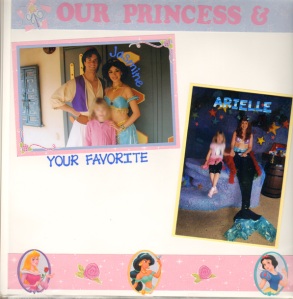
Example of journaling both on and around. Again, mini alphabets stickers were used for the journaling.
Tag Journaling – I love to use this technique when creating school layouts, but this can be used for anything! Tags can be bought at the craft store or regular cardstock can be cut to look like a tag.
Waste Not, Want Not — How To Cram Those Photos Into a Layout!
Two things I am notorious for when it comes to scrapbooking: 1) Fitting as many pictures on a page as I can get away with and 2) Journaling everything! Today I am going to talk about getting those photos crammed into a layout. You’ll have to stay tuned for the journaling tips.
First, let me start off by saying that I love all those beautifully creative layouts with one or two pictures on them. In fact, I have single-picture-per-page envy because I wish I could do that. But I can’t.
Why? For starters, it’s a waste (of time, of pages, of embellishments…) for me. But the main reason is because I have a million pictures accumulating in a clear plastic bin that need to find a permanent home — and fast!
I need to get them out of this bin ASAP and making one-picture spreads just doesn’t work for me. I know you’re out there nodding in agreement, who are in the same position I am in, right? I think what I’m getting at here is go ahead and cram ‘em in. Well, not too much. Then it just looks sloppy. But I’ve been known to put a dozen or more pictures on a 2-page spread. There are many ways you can do that. Collage, tiled, overlapping, silhouetting and clustering are some and I’m going to show you an example of each! These samples are easy and fast. Remember, the point is to get your photos out of a box and into a layout as quickly as possible.
So, what have you learned from this? Waste Not, Want Not! That’s MY motto, why shouldn’t it be YOURS?
Collage Double Layout – Use several photographs and crop them to fit in close proximity of each other. Notice the open space for journaling. This use of space allows for several photos without looking crowded.
Tile #1 – These photos have been cropped to be the same size. This makes your layout look tidy.
Tile #2 – Again, these photos have been cropped to the same size, but they are anchored on one mat.
Overlapping, Silhouetting and Clustering –
Be cautious when you overlap, it can look messy if not carefully thought out. Here I have used 3 photos which allowed more room for others.
The most time-consuming of all techniques, silhouetting, is fun and allows for many photos to fit on a page. There is one rule to silhouetting – make sure you anchor your subject on the page without it looking like a half body is floating in thin air.
Clustering is a super fast, super easy and super way to accommodate a whole bunch of pictures on a layout! The example here shows photos cropped in a circle, but you can use the same technique using any shape you wish. The idea is to cluster them closely together. Why? To save space of course!
Another example of silhouetting– Just remember the rule: Anchor your subject somewhere on the page so that it doesn’t look like body parts are missing.
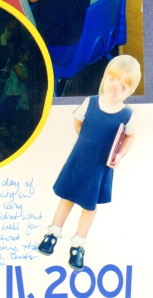
Silhouetting in the middle of the page is acceptable as long as you have the entire subject in the photo and nothing is cut off. This is when it's okay to float a silhouette.
Paper Baseballs For Your Baseball Layouts
I posted this video on Youtube over a year ago, but I figured now is the perfect time to re-visit this idea. Why? Because it’s baseball season and what better time to share again?!
You will need:
- White cardstock
- Circle cutter, circle punch or circle template
- Journal pen
I used the Fiskars 1 1/2″ circle punch and made a few circles out of white cardstock. Then, using part of one of the circles as a guide, I drew in the “stitches” with a journal pen in an arc pattern. That’s it! These cute baseballs are so easy, you can knock out a ton of them in no time flat!
